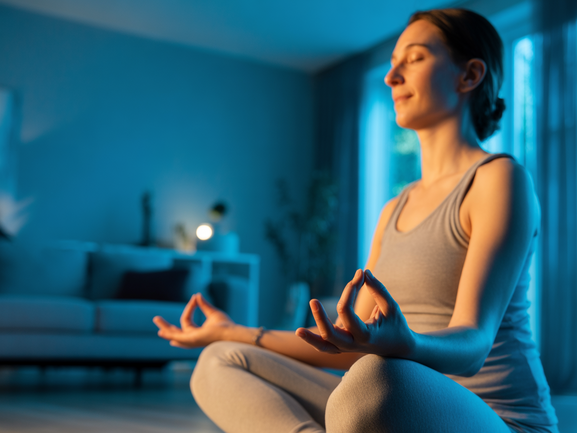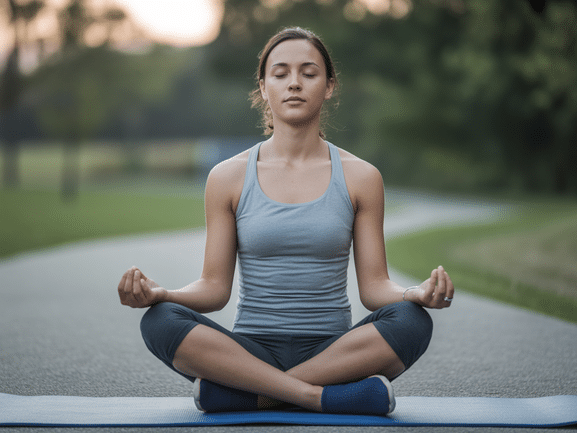Meditation for Beginners: Your Gentle Guide to Finding Inner Peace
Do you ever feel like your mind is a browser with 47 tabs open? If you’re nodding along, you’re not alone. In our fast-paced world, millions of people are discovering that meditation for beginners isn’t just a trend—it’s a necessity for mental well-being.
Perhaps you’ve heard friends rave about their meditation practice, or maybe you’ve seen countless articles about mindfulness tips flooding your social media. The truth is, learning how to start meditating doesn’t require years of spiritual training or sitting cross-legged for hours. In fact, the most effective beginner meditation techniques can be learned in just a few minutes.
What is Meditation? (Simpler Than You Think)
At its core, meditation is simply the practice of focusing your attention and eliminating the stream of jumbled thoughts that may be crowding your mind. Think of it as a mental shower—a way to cleanse your thoughts and start fresh.
Contrary to popular belief, meditation isn’t about:
- Completely emptying your mind
- Achieving instant enlightenment
- Sitting in uncomfortable positions
- Chanting in ancient languages
Instead, simple meditation practices are about developing awareness, reducing stress, and finding moments of peace in your daily routine. Moreover, modern meditation apps like Vitalizen make it incredibly accessible for anyone to begin their journey.
5 Beginner-Friendly Meditation Techniques
Ready to dive in? Here are five easy meditation for complete beginners techniques that you can start practicing today:
1. Breath Awareness Meditation (2-3 Minutes)
This is the foundation of all meditation practices. Simply:
- Find a comfortable seated position
- Close your eyes or soften your gaze
- Focus on your natural breathing rhythm
- When your mind wanders (and it will!), gently return attention to your breath
Start with just 2-3 minutes daily. Remember, there’s no “perfect” way to breathe—just observe what comes naturally.
2. Body Scan Meditation
This technique helps you connect with physical sensations and release tension:
- Lie down comfortably
- Start at the top of your head
- Slowly move your attention down through each part of your body
- Notice any sensations without trying to change them
- Continue until you reach your toes
This practice is particularly effective for mindfulness exercises for stress relief after a long workday.
3. Guided Visualization
Perfect for beginners who find it challenging to focus independently:
- Choose a peaceful setting (beach, forest, mountain)
- Visualize yourself there in detail
- Engage all your senses—what do you hear, smell, feel?
- Let the imagery guide your relaxation
The Vitalizen app offers hundreds of guided visualizations specifically designed for beginners.
4. Walking Meditation
Who said meditation requires sitting still? This technique combines movement with mindfulness:
- Choose a quiet path 10-20 steps long
- Walk slowly and deliberately
- Focus on the sensation of your feet touching the ground
- When you reach the end, pause and turn around mindfully
This is excellent for people who struggle with traditional seated meditation.
5. Loving-Kindness Meditation
This practice cultivates compassion and positive emotions:
- Begin by sending kind thoughts to yourself
- Extend these feelings to loved ones
- Gradually include neutral people, then difficult people
- Finally, send loving-kindness to all beings
Research shows this practice can significantly improve emotional well-being and reduce anxiety.
Common Beginner Mistakes to Avoid
Even with the best intentions, new meditators often encounter these pitfalls:
Expecting Immediate Results
Meditation is like going to the gym—you wouldn’t expect to bench press 200 pounds on your first day. Similarly, the benefits of meditation develop gradually over time.
Judging Your Thoughts
When thoughts arise during meditation (and they will), don’t fight them. Instead, acknowledge them gently and return to your focus point. This “noticing and returning” is the practice.
Setting Unrealistic Goals
Starting with 20-30 minute sessions often leads to frustration. Instead, begin with 2-5 minutes and gradually increase as the habit solidifies.
Comparing Your Experience
Your meditation journey is unique. Avoid comparing your experience to others or to what you think it “should” be like.
How to Build a Daily Practice
Consistency trumps duration when it comes to meditation. Here’s how to establish a sustainable routine:
Start Small
Begin with just 2-3 minutes daily. Once this becomes natural, gradually increase the duration. Furthermore, short consistent sessions are more beneficial than occasional long ones.
Choose a Consistent Time
Many people find morning meditation sets a positive tone for the day. However, the best time is whenever you can be consistent. Whether it’s during your lunch break or before bed, pick a time that works for your schedule.
Create a Dedicated Space
You don’t need a elaborate meditation room. A quiet corner with a cushion or chair works perfectly. The key is consistency—using the same space helps signal to your brain that it’s time to meditate.
Use Technology Wisely
Apps like Vitalizen provide structured programs, progress tracking, and community support that can significantly boost your motivation and success rate.
Benefits You’ll Notice Quickly
While long-term meditation offers profound benefits, you might notice these changes within just a few weeks:
- Improved Sleep Quality: Many beginners report falling asleep faster and experiencing deeper rest
- Better Stress Management: You’ll develop tools to handle daily stressors more effectively
- Enhanced Focus: Concentration improves both during meditation and throughout your day
- Increased Self-Awareness: You’ll become more attuned to your thoughts, emotions, and reactions
- Greater Emotional Regulation: Difficult emotions become more manageable
Research from Harvard Medical School shows that even 8 weeks of regular meditation can create measurable changes in brain structure related to memory, empathy, and stress.
Ready to Begin Your Journey?
Starting a meditation practice doesn’t have to be overwhelming. With the


